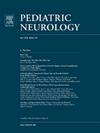Common Data Elements Regarding Social Determinants of Health in Pediatric Epilepsy Research: A Concept Mapping Study
IF 3.2
3区 医学
Q2 CLINICAL NEUROLOGY
引用次数: 0
Abstract
Background
The Pediatric Epilepsy Research Consortium (PERC) Health Equity Special Interest Group (SIG) used Concept Mapping to begin developing Common Data Elements (CDE) about social determinants of health to standardize data collection and facilitate robust evaluation of health disparities in pediatric epilepsy research.
Methods
Concept Mapping is a structured participatory mixed method suited for developing group consensus. PERC members (1) identified social factors that are important to measure in pediatric epilepsy research, (2) sorted factors into meaningful categories, and (3) rated the factors on importance and ease of measurement. The authors applied multidimensional scaling to the sorting data, created spatial point maps, and used hierarchical cluster analysis to define concepts. A bivariate scatterplot was used to explore importance versus ease of measurement to prioritize factors for inclusion. The PERC Health Equity SIG met on three occasions to interpret research findings and finalize a CDE set.
Results
Eighty-one PERC members generated 110 candidate factors. Thirty PERC members completed sorting, and 48 completed rating. The factors grouped into a five-cluster solution: “Household and Neighborhood Resources,” “Family Context,” “Individual Demographics,” “Healthcare Experiences,” and “School.” Sixty-two items were rated with high importance, of which 34 were rated with high ease. The PERC Health Equity SIG decided by consensus to include most items with high importance and high ease ratings, plus selected additional items. The final CDE set consists of 42 items.
Conclusions
Inclusion of CDE in future pediatric epilepsy research will enable researchers to undertake systematic analyses of health disparities.
关于儿童癫痫研究中健康的社会决定因素的共同数据要素:一项概念映射研究
儿童癫痫研究联盟(PERC)卫生公平特别兴趣小组(SIG)使用概念映射开始开发关于健康社会决定因素的公共数据元素(CDE),以标准化数据收集并促进对儿童癫痫研究中健康差异的有力评估。方法概念映射是一种适合于形成群体共识的结构化参与式混合方法。PERC成员(1)确定在儿童癫痫研究中需要测量的重要社会因素;(2)将这些因素分类为有意义的类别;(3)对这些因素的重要性和测量难易程度进行评分。作者将多维尺度应用于排序数据,创建空间点图,并使用分层聚类分析来定义概念。使用双变量散点图来探索重要性与测量难易程度,以确定纳入因素的优先顺序。PERC健康公平小组召开了三次会议,解释研究结果并最终确定了CDE集。结果81个PERC成员生成110个候选因子。30名PERC成员完成了分类,48名完成了评级。这些因素分为五个集群解决方案:“家庭和社区资源”、“家庭背景”、“个人人口统计”、“医疗保健经历”和“学校”。62个项目被评为高度重要,其中34个项目被评为高度容易。PERC健康权益小组经协商一致决定包括大多数具有高重要性和高易用性评级的项目,以及选定的附加项目。最终的CDE集由42个项目组成。结论将CDE纳入未来的儿童癫痫研究将使研究人员能够对健康差异进行系统分析。
本文章由计算机程序翻译,如有差异,请以英文原文为准。
求助全文
约1分钟内获得全文
求助全文
来源期刊

Pediatric neurology
医学-临床神经学
CiteScore
4.80
自引率
2.60%
发文量
176
审稿时长
78 days
期刊介绍:
Pediatric Neurology publishes timely peer-reviewed clinical and research articles covering all aspects of the developing nervous system.
Pediatric Neurology features up-to-the-minute publication of the latest advances in the diagnosis, management, and treatment of pediatric neurologic disorders. The journal''s editor, E. Steve Roach, in conjunction with the team of Associate Editors, heads an internationally recognized editorial board, ensuring the most authoritative and extensive coverage of the field. Among the topics covered are: epilepsy, mitochondrial diseases, congenital malformations, chromosomopathies, peripheral neuropathies, perinatal and childhood stroke, cerebral palsy, as well as other diseases affecting the developing nervous system.
 求助内容:
求助内容: 应助结果提醒方式:
应助结果提醒方式:


